Essay on Depression: Determinants, Systems, and Socioeconomic Factors
VerifiedAdded on 2021/09/12
|7
|1625
|309
Essay
AI Summary
This essay explores the multifaceted nature of depression, defining it as a state of prolonged sadness, loss of motivation, and reduced enjoyment. It highlights the global impact of depression, citing statistics from the Australian Bureau of Statistics and the Australian Institute of Health and Welfare, emphasizing its prevalence and impact on both males and females, and its status as a leading cause of disability. The essay delves into various determinants of depression, including socioeconomic status, biological factors like neurotrophic growth factors, lifestyle choices, and environmental factors such as natural disasters. It then examines the role of Australian health systems like SANE, PANDA, Beyond Blue, and the Department of Health Australia in addressing depression through awareness campaigns, helplines, research funding, and health promotion programs aimed at supporting individuals and addressing the diverse factors contributing to this mental health issue. The essay concludes by summarizing the key determinants and the crucial role of various health systems in combating depression.
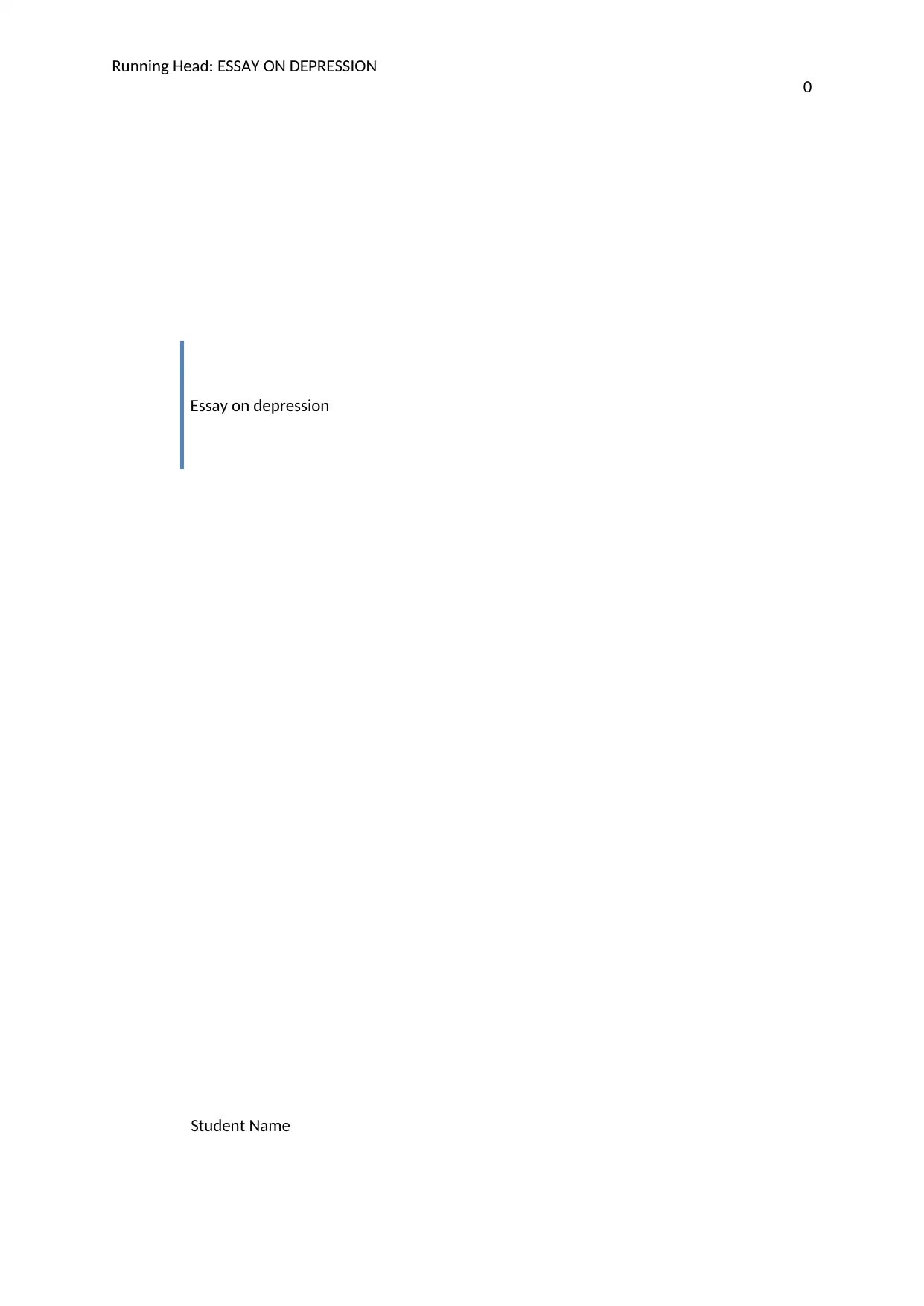
Running Head: ESSAY ON DEPRESSION
0
Essay on depression
Student Name
0
Essay on depression
Student Name
Paraphrase This Document
Need a fresh take? Get an instant paraphrase of this document with our AI Paraphraser
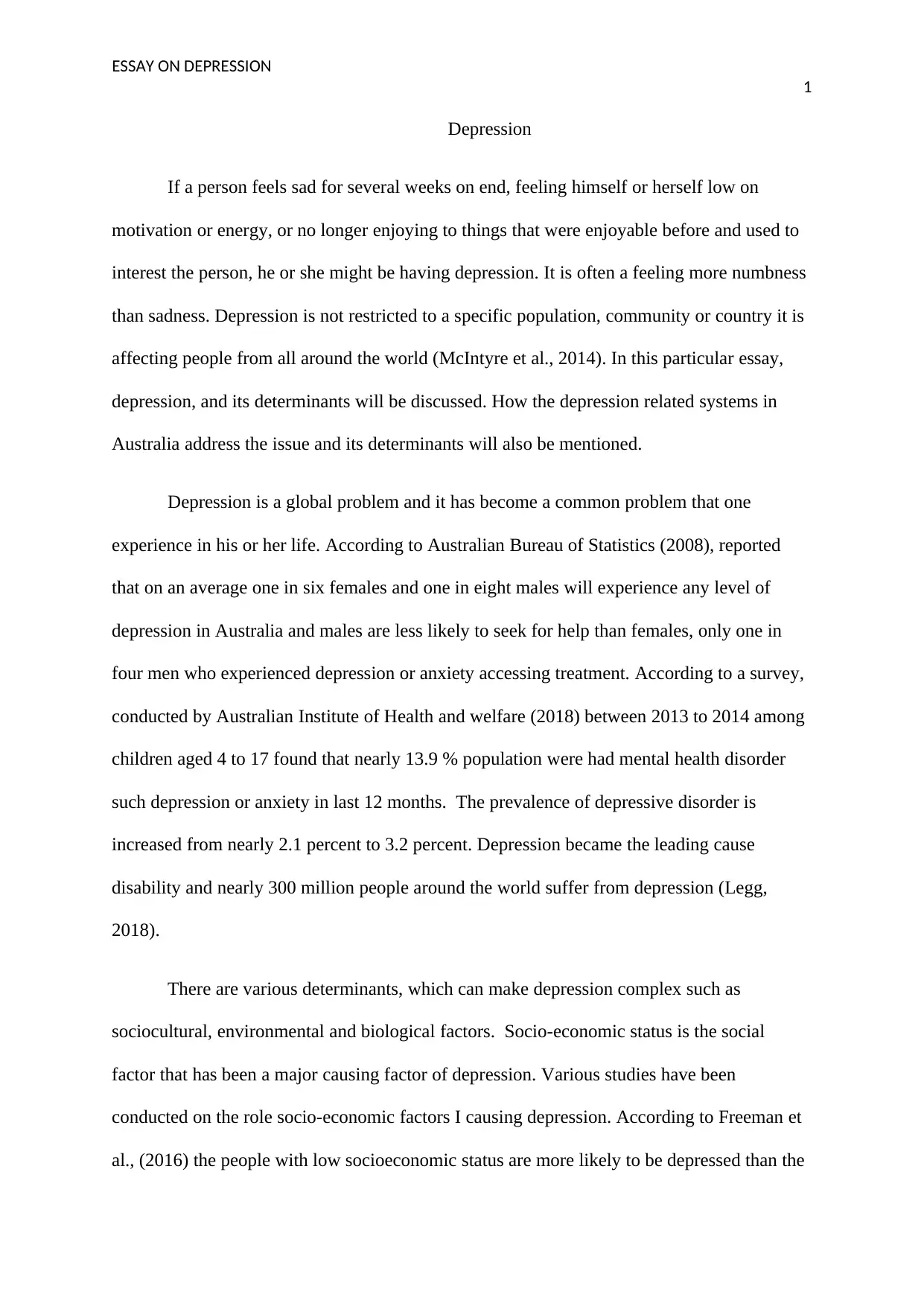
ESSAY ON DEPRESSION
1
Depression
If a person feels sad for several weeks on end, feeling himself or herself low on
motivation or energy, or no longer enjoying to things that were enjoyable before and used to
interest the person, he or she might be having depression. It is often a feeling more numbness
than sadness. Depression is not restricted to a specific population, community or country it is
affecting people from all around the world (McIntyre et al., 2014). In this particular essay,
depression, and its determinants will be discussed. How the depression related systems in
Australia address the issue and its determinants will also be mentioned.
Depression is a global problem and it has become a common problem that one
experience in his or her life. According to Australian Bureau of Statistics (2008), reported
that on an average one in six females and one in eight males will experience any level of
depression in Australia and males are less likely to seek for help than females, only one in
four men who experienced depression or anxiety accessing treatment. According to a survey,
conducted by Australian Institute of Health and welfare (2018) between 2013 to 2014 among
children aged 4 to 17 found that nearly 13.9 % population were had mental health disorder
such depression or anxiety in last 12 months. The prevalence of depressive disorder is
increased from nearly 2.1 percent to 3.2 percent. Depression became the leading cause
disability and nearly 300 million people around the world suffer from depression (Legg,
2018).
There are various determinants, which can make depression complex such as
sociocultural, environmental and biological factors. Socio-economic status is the social
factor that has been a major causing factor of depression. Various studies have been
conducted on the role socio-economic factors I causing depression. According to Freeman et
al., (2016) the people with low socioeconomic status are more likely to be depressed than the
1
Depression
If a person feels sad for several weeks on end, feeling himself or herself low on
motivation or energy, or no longer enjoying to things that were enjoyable before and used to
interest the person, he or she might be having depression. It is often a feeling more numbness
than sadness. Depression is not restricted to a specific population, community or country it is
affecting people from all around the world (McIntyre et al., 2014). In this particular essay,
depression, and its determinants will be discussed. How the depression related systems in
Australia address the issue and its determinants will also be mentioned.
Depression is a global problem and it has become a common problem that one
experience in his or her life. According to Australian Bureau of Statistics (2008), reported
that on an average one in six females and one in eight males will experience any level of
depression in Australia and males are less likely to seek for help than females, only one in
four men who experienced depression or anxiety accessing treatment. According to a survey,
conducted by Australian Institute of Health and welfare (2018) between 2013 to 2014 among
children aged 4 to 17 found that nearly 13.9 % population were had mental health disorder
such depression or anxiety in last 12 months. The prevalence of depressive disorder is
increased from nearly 2.1 percent to 3.2 percent. Depression became the leading cause
disability and nearly 300 million people around the world suffer from depression (Legg,
2018).
There are various determinants, which can make depression complex such as
sociocultural, environmental and biological factors. Socio-economic status is the social
factor that has been a major causing factor of depression. Various studies have been
conducted on the role socio-economic factors I causing depression. According to Freeman et
al., (2016) the people with low socioeconomic status are more likely to be depressed than the
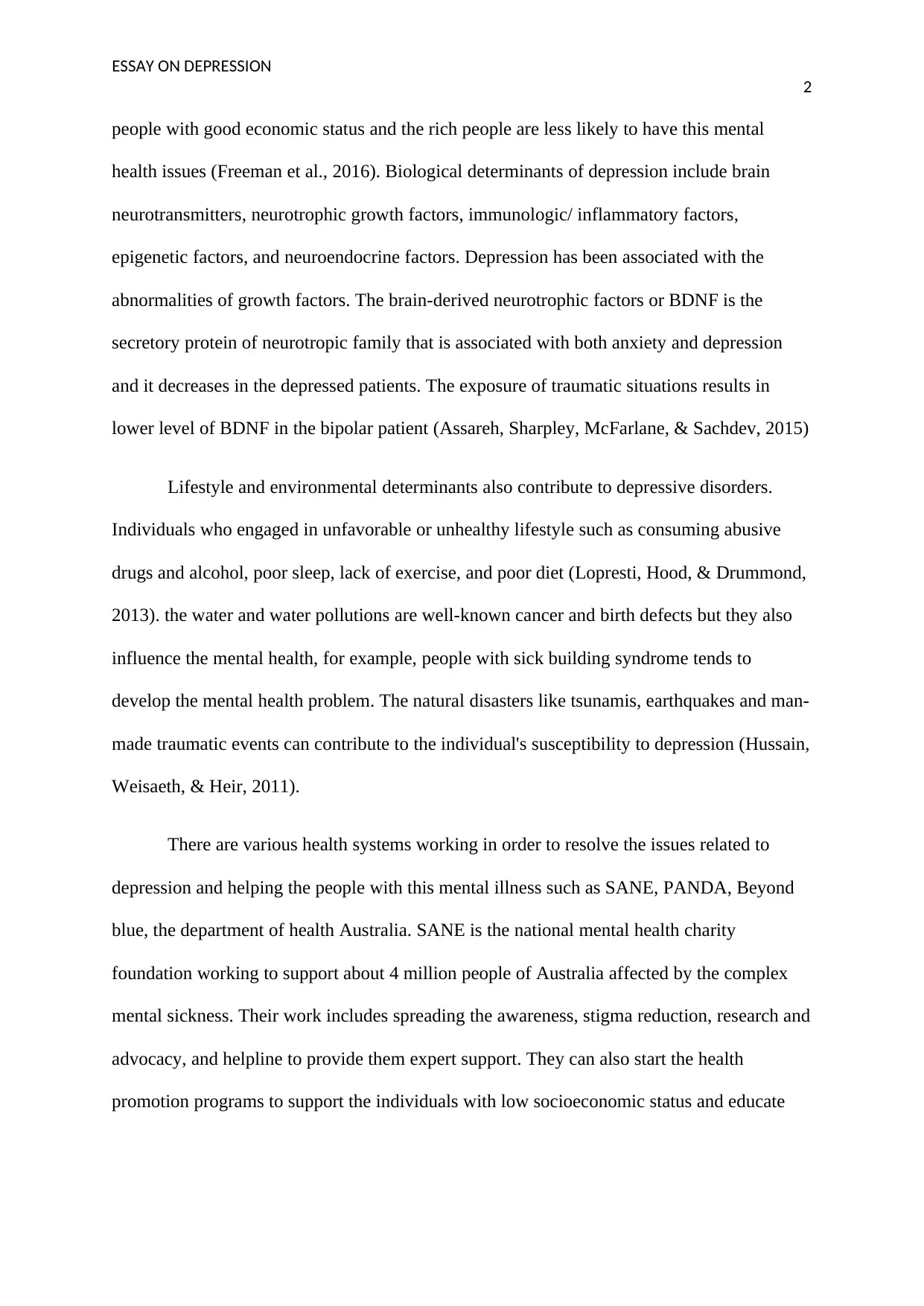
ESSAY ON DEPRESSION
2
people with good economic status and the rich people are less likely to have this mental
health issues (Freeman et al., 2016). Biological determinants of depression include brain
neurotransmitters, neurotrophic growth factors, immunologic/ inflammatory factors,
epigenetic factors, and neuroendocrine factors. Depression has been associated with the
abnormalities of growth factors. The brain-derived neurotrophic factors or BDNF is the
secretory protein of neurotropic family that is associated with both anxiety and depression
and it decreases in the depressed patients. The exposure of traumatic situations results in
lower level of BDNF in the bipolar patient (Assareh, Sharpley, McFarlane, & Sachdev, 2015)
Lifestyle and environmental determinants also contribute to depressive disorders.
Individuals who engaged in unfavorable or unhealthy lifestyle such as consuming abusive
drugs and alcohol, poor sleep, lack of exercise, and poor diet (Lopresti, Hood, & Drummond,
2013). the water and water pollutions are well-known cancer and birth defects but they also
influence the mental health, for example, people with sick building syndrome tends to
develop the mental health problem. The natural disasters like tsunamis, earthquakes and man-
made traumatic events can contribute to the individual's susceptibility to depression (Hussain,
Weisaeth, & Heir, 2011).
There are various health systems working in order to resolve the issues related to
depression and helping the people with this mental illness such as SANE, PANDA, Beyond
blue, the department of health Australia. SANE is the national mental health charity
foundation working to support about 4 million people of Australia affected by the complex
mental sickness. Their work includes spreading the awareness, stigma reduction, research and
advocacy, and helpline to provide them expert support. They can also start the health
promotion programs to support the individuals with low socioeconomic status and educate
2
people with good economic status and the rich people are less likely to have this mental
health issues (Freeman et al., 2016). Biological determinants of depression include brain
neurotransmitters, neurotrophic growth factors, immunologic/ inflammatory factors,
epigenetic factors, and neuroendocrine factors. Depression has been associated with the
abnormalities of growth factors. The brain-derived neurotrophic factors or BDNF is the
secretory protein of neurotropic family that is associated with both anxiety and depression
and it decreases in the depressed patients. The exposure of traumatic situations results in
lower level of BDNF in the bipolar patient (Assareh, Sharpley, McFarlane, & Sachdev, 2015)
Lifestyle and environmental determinants also contribute to depressive disorders.
Individuals who engaged in unfavorable or unhealthy lifestyle such as consuming abusive
drugs and alcohol, poor sleep, lack of exercise, and poor diet (Lopresti, Hood, & Drummond,
2013). the water and water pollutions are well-known cancer and birth defects but they also
influence the mental health, for example, people with sick building syndrome tends to
develop the mental health problem. The natural disasters like tsunamis, earthquakes and man-
made traumatic events can contribute to the individual's susceptibility to depression (Hussain,
Weisaeth, & Heir, 2011).
There are various health systems working in order to resolve the issues related to
depression and helping the people with this mental illness such as SANE, PANDA, Beyond
blue, the department of health Australia. SANE is the national mental health charity
foundation working to support about 4 million people of Australia affected by the complex
mental sickness. Their work includes spreading the awareness, stigma reduction, research and
advocacy, and helpline to provide them expert support. They can also start the health
promotion programs to support the individuals with low socioeconomic status and educate
⊘ This is a preview!⊘
Do you want full access?
Subscribe today to unlock all pages.

Trusted by 1+ million students worldwide
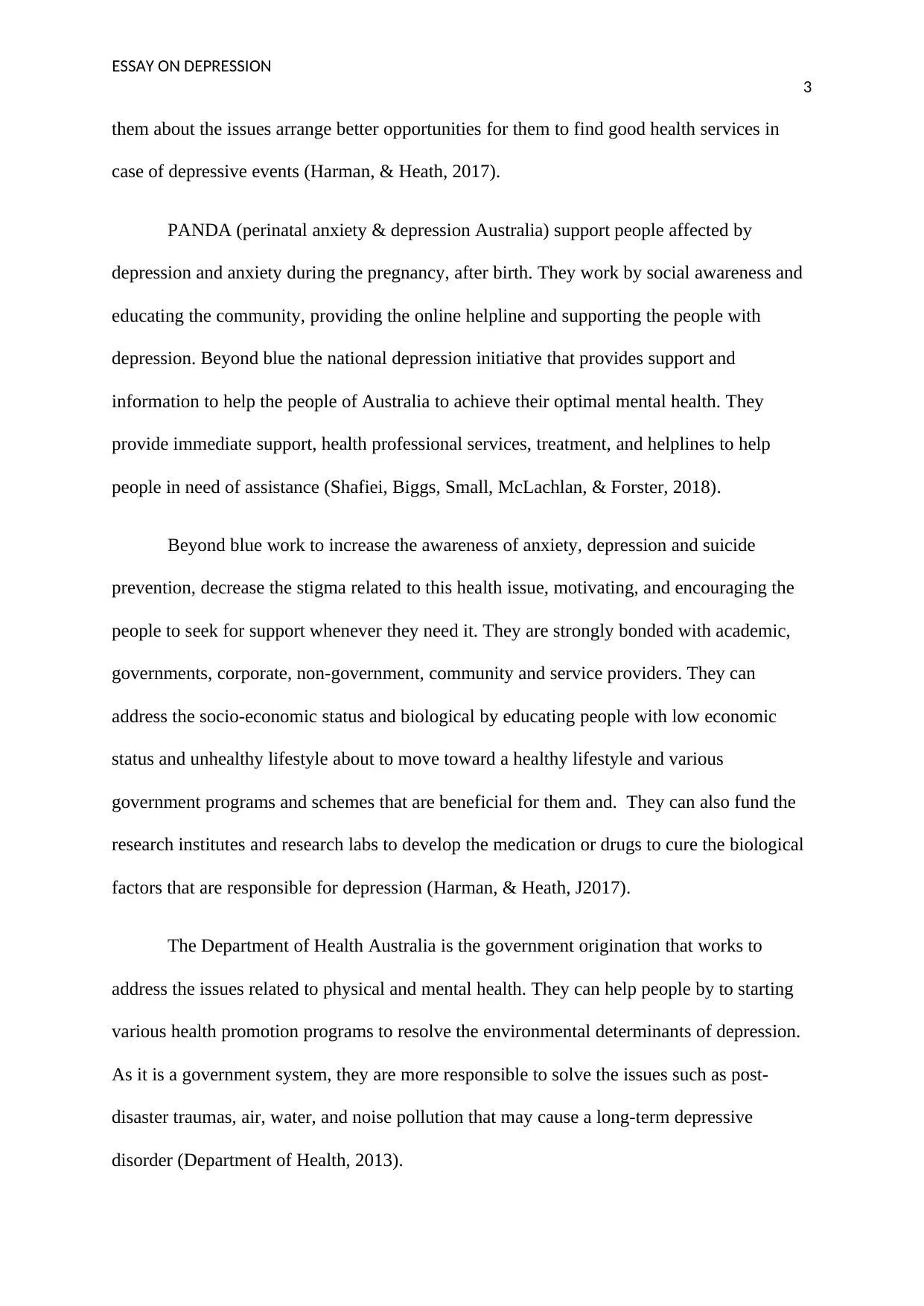
ESSAY ON DEPRESSION
3
them about the issues arrange better opportunities for them to find good health services in
case of depressive events (Harman, & Heath, 2017).
PANDA (perinatal anxiety & depression Australia) support people affected by
depression and anxiety during the pregnancy, after birth. They work by social awareness and
educating the community, providing the online helpline and supporting the people with
depression. Beyond blue the national depression initiative that provides support and
information to help the people of Australia to achieve their optimal mental health. They
provide immediate support, health professional services, treatment, and helplines to help
people in need of assistance (Shafiei, Biggs, Small, McLachlan, & Forster, 2018).
Beyond blue work to increase the awareness of anxiety, depression and suicide
prevention, decrease the stigma related to this health issue, motivating, and encouraging the
people to seek for support whenever they need it. They are strongly bonded with academic,
governments, corporate, non-government, community and service providers. They can
address the socio-economic status and biological by educating people with low economic
status and unhealthy lifestyle about to move toward a healthy lifestyle and various
government programs and schemes that are beneficial for them and. They can also fund the
research institutes and research labs to develop the medication or drugs to cure the biological
factors that are responsible for depression (Harman, & Heath, J2017).
The Department of Health Australia is the government origination that works to
address the issues related to physical and mental health. They can help people by to starting
various health promotion programs to resolve the environmental determinants of depression.
As it is a government system, they are more responsible to solve the issues such as post-
disaster traumas, air, water, and noise pollution that may cause a long-term depressive
disorder (Department of Health, 2013).
3
them about the issues arrange better opportunities for them to find good health services in
case of depressive events (Harman, & Heath, 2017).
PANDA (perinatal anxiety & depression Australia) support people affected by
depression and anxiety during the pregnancy, after birth. They work by social awareness and
educating the community, providing the online helpline and supporting the people with
depression. Beyond blue the national depression initiative that provides support and
information to help the people of Australia to achieve their optimal mental health. They
provide immediate support, health professional services, treatment, and helplines to help
people in need of assistance (Shafiei, Biggs, Small, McLachlan, & Forster, 2018).
Beyond blue work to increase the awareness of anxiety, depression and suicide
prevention, decrease the stigma related to this health issue, motivating, and encouraging the
people to seek for support whenever they need it. They are strongly bonded with academic,
governments, corporate, non-government, community and service providers. They can
address the socio-economic status and biological by educating people with low economic
status and unhealthy lifestyle about to move toward a healthy lifestyle and various
government programs and schemes that are beneficial for them and. They can also fund the
research institutes and research labs to develop the medication or drugs to cure the biological
factors that are responsible for depression (Harman, & Heath, J2017).
The Department of Health Australia is the government origination that works to
address the issues related to physical and mental health. They can help people by to starting
various health promotion programs to resolve the environmental determinants of depression.
As it is a government system, they are more responsible to solve the issues such as post-
disaster traumas, air, water, and noise pollution that may cause a long-term depressive
disorder (Department of Health, 2013).
Paraphrase This Document
Need a fresh take? Get an instant paraphrase of this document with our AI Paraphraser
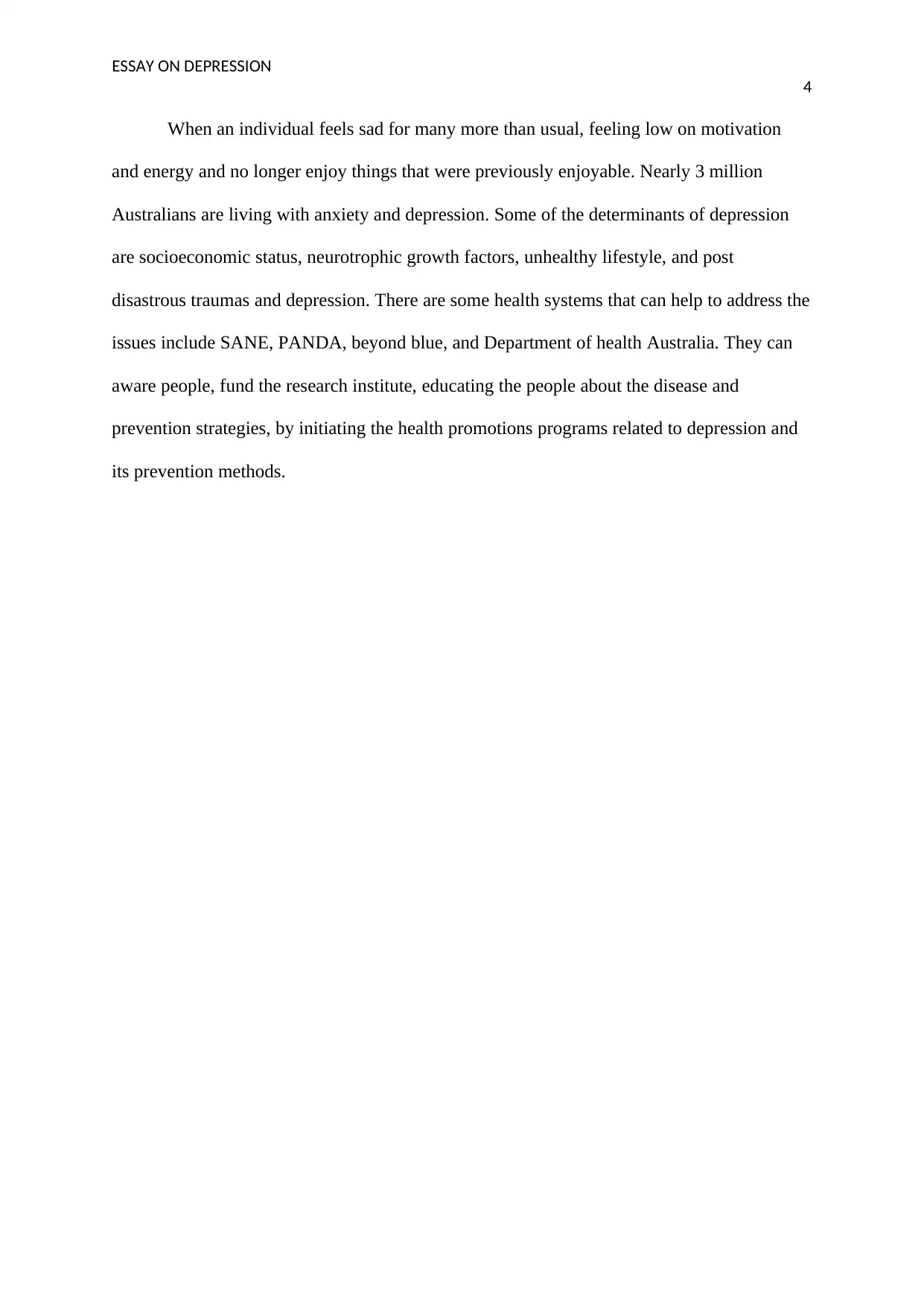
ESSAY ON DEPRESSION
4
When an individual feels sad for many more than usual, feeling low on motivation
and energy and no longer enjoy things that were previously enjoyable. Nearly 3 million
Australians are living with anxiety and depression. Some of the determinants of depression
are socioeconomic status, neurotrophic growth factors, unhealthy lifestyle, and post
disastrous traumas and depression. There are some health systems that can help to address the
issues include SANE, PANDA, beyond blue, and Department of health Australia. They can
aware people, fund the research institute, educating the people about the disease and
prevention strategies, by initiating the health promotions programs related to depression and
its prevention methods.
4
When an individual feels sad for many more than usual, feeling low on motivation
and energy and no longer enjoy things that were previously enjoyable. Nearly 3 million
Australians are living with anxiety and depression. Some of the determinants of depression
are socioeconomic status, neurotrophic growth factors, unhealthy lifestyle, and post
disastrous traumas and depression. There are some health systems that can help to address the
issues include SANE, PANDA, beyond blue, and Department of health Australia. They can
aware people, fund the research institute, educating the people about the disease and
prevention strategies, by initiating the health promotions programs related to depression and
its prevention methods.
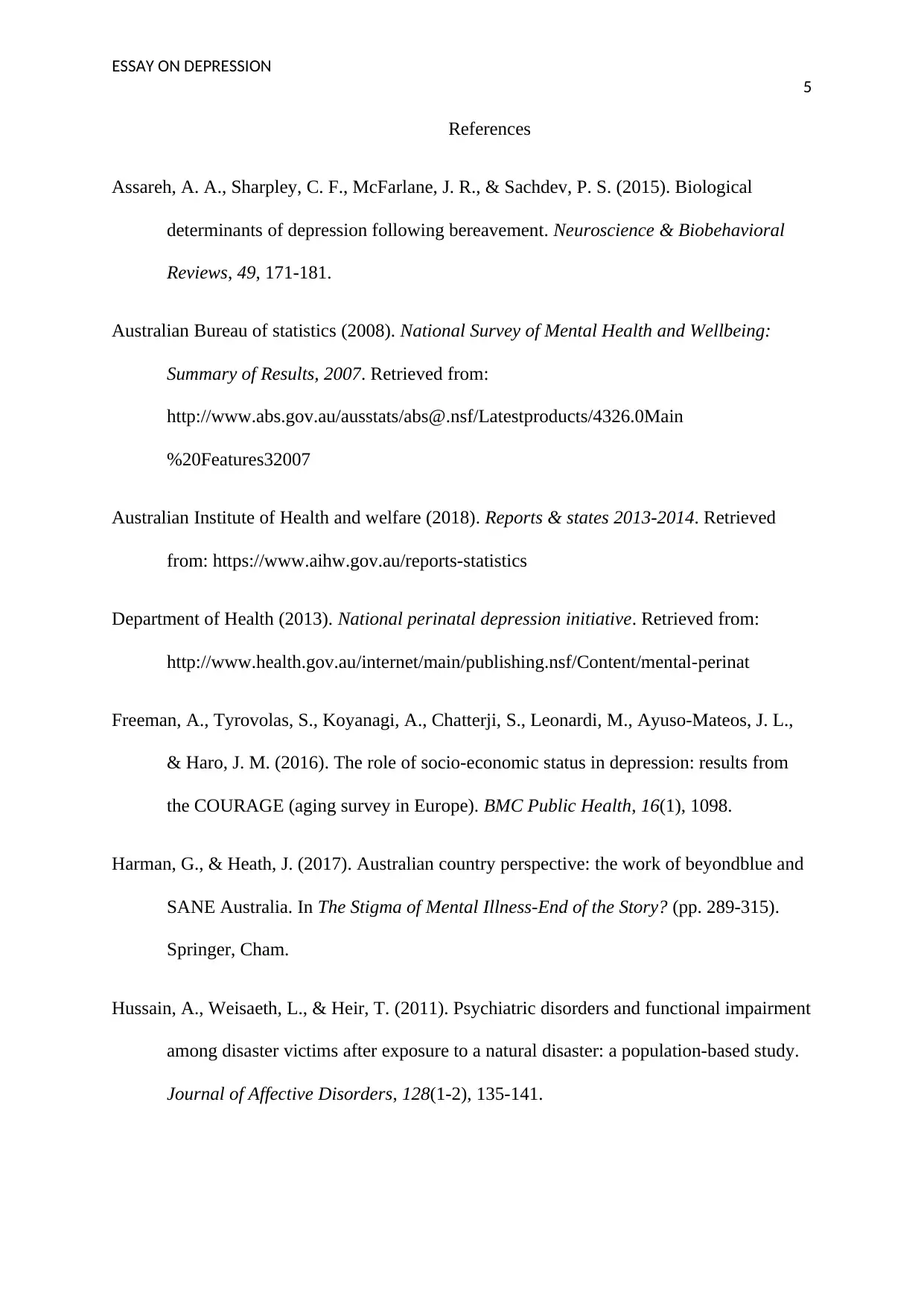
ESSAY ON DEPRESSION
5
References
Assareh, A. A., Sharpley, C. F., McFarlane, J. R., & Sachdev, P. S. (2015). Biological
determinants of depression following bereavement. Neuroscience & Biobehavioral
Reviews, 49, 171-181.
Australian Bureau of statistics (2008). National Survey of Mental Health and Wellbeing:
Summary of Results, 2007. Retrieved from:
http://www.abs.gov.au/ausstats/abs@.nsf/Latestproducts/4326.0Main
%20Features32007
Australian Institute of Health and welfare (2018). Reports & states 2013-2014. Retrieved
from: https://www.aihw.gov.au/reports-statistics
Department of Health (2013). National perinatal depression initiative. Retrieved from:
http://www.health.gov.au/internet/main/publishing.nsf/Content/mental-perinat
Freeman, A., Tyrovolas, S., Koyanagi, A., Chatterji, S., Leonardi, M., Ayuso-Mateos, J. L.,
& Haro, J. M. (2016). The role of socio-economic status in depression: results from
the COURAGE (aging survey in Europe). BMC Public Health, 16(1), 1098.
Harman, G., & Heath, J. (2017). Australian country perspective: the work of beyondblue and
SANE Australia. In The Stigma of Mental Illness-End of the Story? (pp. 289-315).
Springer, Cham.
Hussain, A., Weisaeth, L., & Heir, T. (2011). Psychiatric disorders and functional impairment
among disaster victims after exposure to a natural disaster: a population-based study.
Journal of Affective Disorders, 128(1-2), 135-141.
5
References
Assareh, A. A., Sharpley, C. F., McFarlane, J. R., & Sachdev, P. S. (2015). Biological
determinants of depression following bereavement. Neuroscience & Biobehavioral
Reviews, 49, 171-181.
Australian Bureau of statistics (2008). National Survey of Mental Health and Wellbeing:
Summary of Results, 2007. Retrieved from:
http://www.abs.gov.au/ausstats/abs@.nsf/Latestproducts/4326.0Main
%20Features32007
Australian Institute of Health and welfare (2018). Reports & states 2013-2014. Retrieved
from: https://www.aihw.gov.au/reports-statistics
Department of Health (2013). National perinatal depression initiative. Retrieved from:
http://www.health.gov.au/internet/main/publishing.nsf/Content/mental-perinat
Freeman, A., Tyrovolas, S., Koyanagi, A., Chatterji, S., Leonardi, M., Ayuso-Mateos, J. L.,
& Haro, J. M. (2016). The role of socio-economic status in depression: results from
the COURAGE (aging survey in Europe). BMC Public Health, 16(1), 1098.
Harman, G., & Heath, J. (2017). Australian country perspective: the work of beyondblue and
SANE Australia. In The Stigma of Mental Illness-End of the Story? (pp. 289-315).
Springer, Cham.
Hussain, A., Weisaeth, L., & Heir, T. (2011). Psychiatric disorders and functional impairment
among disaster victims after exposure to a natural disaster: a population-based study.
Journal of Affective Disorders, 128(1-2), 135-141.
⊘ This is a preview!⊘
Do you want full access?
Subscribe today to unlock all pages.

Trusted by 1+ million students worldwide
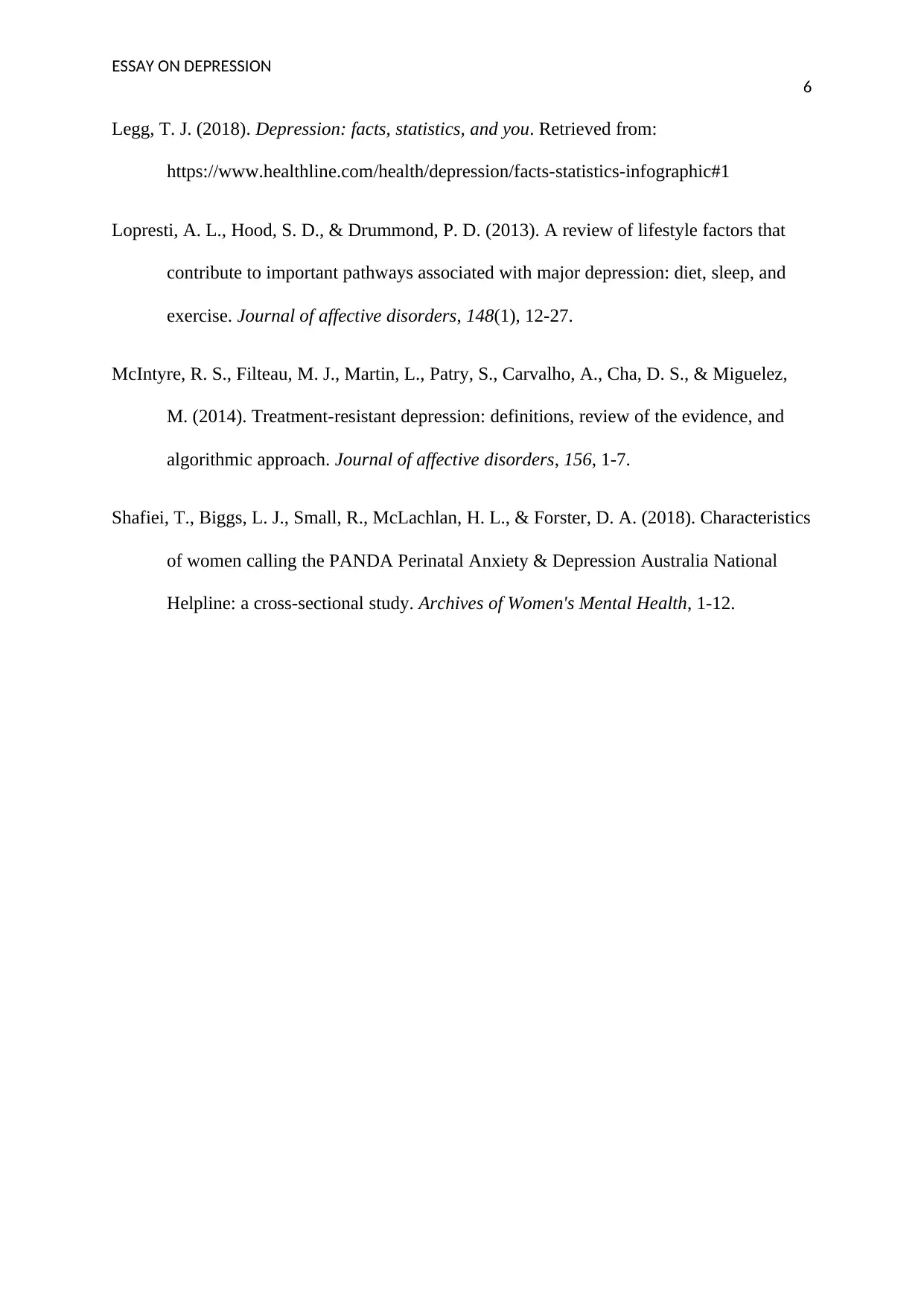
ESSAY ON DEPRESSION
6
Legg, T. J. (2018). Depression: facts, statistics, and you. Retrieved from:
https://www.healthline.com/health/depression/facts-statistics-infographic#1
Lopresti, A. L., Hood, S. D., & Drummond, P. D. (2013). A review of lifestyle factors that
contribute to important pathways associated with major depression: diet, sleep, and
exercise. Journal of affective disorders, 148(1), 12-27.
McIntyre, R. S., Filteau, M. J., Martin, L., Patry, S., Carvalho, A., Cha, D. S., & Miguelez,
M. (2014). Treatment-resistant depression: definitions, review of the evidence, and
algorithmic approach. Journal of affective disorders, 156, 1-7.
Shafiei, T., Biggs, L. J., Small, R., McLachlan, H. L., & Forster, D. A. (2018). Characteristics
of women calling the PANDA Perinatal Anxiety & Depression Australia National
Helpline: a cross-sectional study. Archives of Women's Mental Health, 1-12.
6
Legg, T. J. (2018). Depression: facts, statistics, and you. Retrieved from:
https://www.healthline.com/health/depression/facts-statistics-infographic#1
Lopresti, A. L., Hood, S. D., & Drummond, P. D. (2013). A review of lifestyle factors that
contribute to important pathways associated with major depression: diet, sleep, and
exercise. Journal of affective disorders, 148(1), 12-27.
McIntyre, R. S., Filteau, M. J., Martin, L., Patry, S., Carvalho, A., Cha, D. S., & Miguelez,
M. (2014). Treatment-resistant depression: definitions, review of the evidence, and
algorithmic approach. Journal of affective disorders, 156, 1-7.
Shafiei, T., Biggs, L. J., Small, R., McLachlan, H. L., & Forster, D. A. (2018). Characteristics
of women calling the PANDA Perinatal Anxiety & Depression Australia National
Helpline: a cross-sectional study. Archives of Women's Mental Health, 1-12.
1 out of 7
Related Documents
Your All-in-One AI-Powered Toolkit for Academic Success.
+13062052269
info@desklib.com
Available 24*7 on WhatsApp / Email
![[object Object]](/_next/static/media/star-bottom.7253800d.svg)
Unlock your academic potential
Copyright © 2020–2025 A2Z Services. All Rights Reserved. Developed and managed by ZUCOL.





